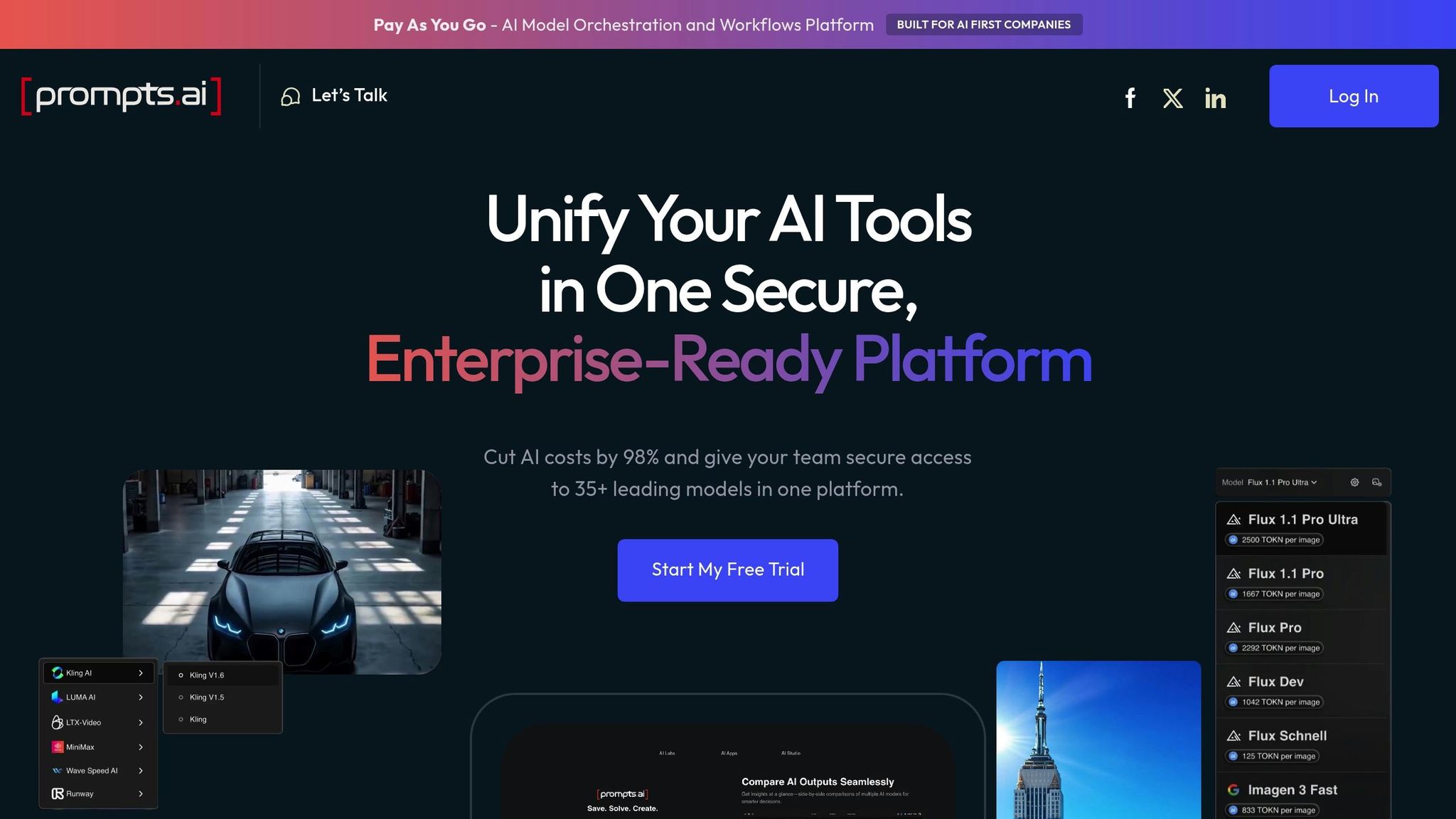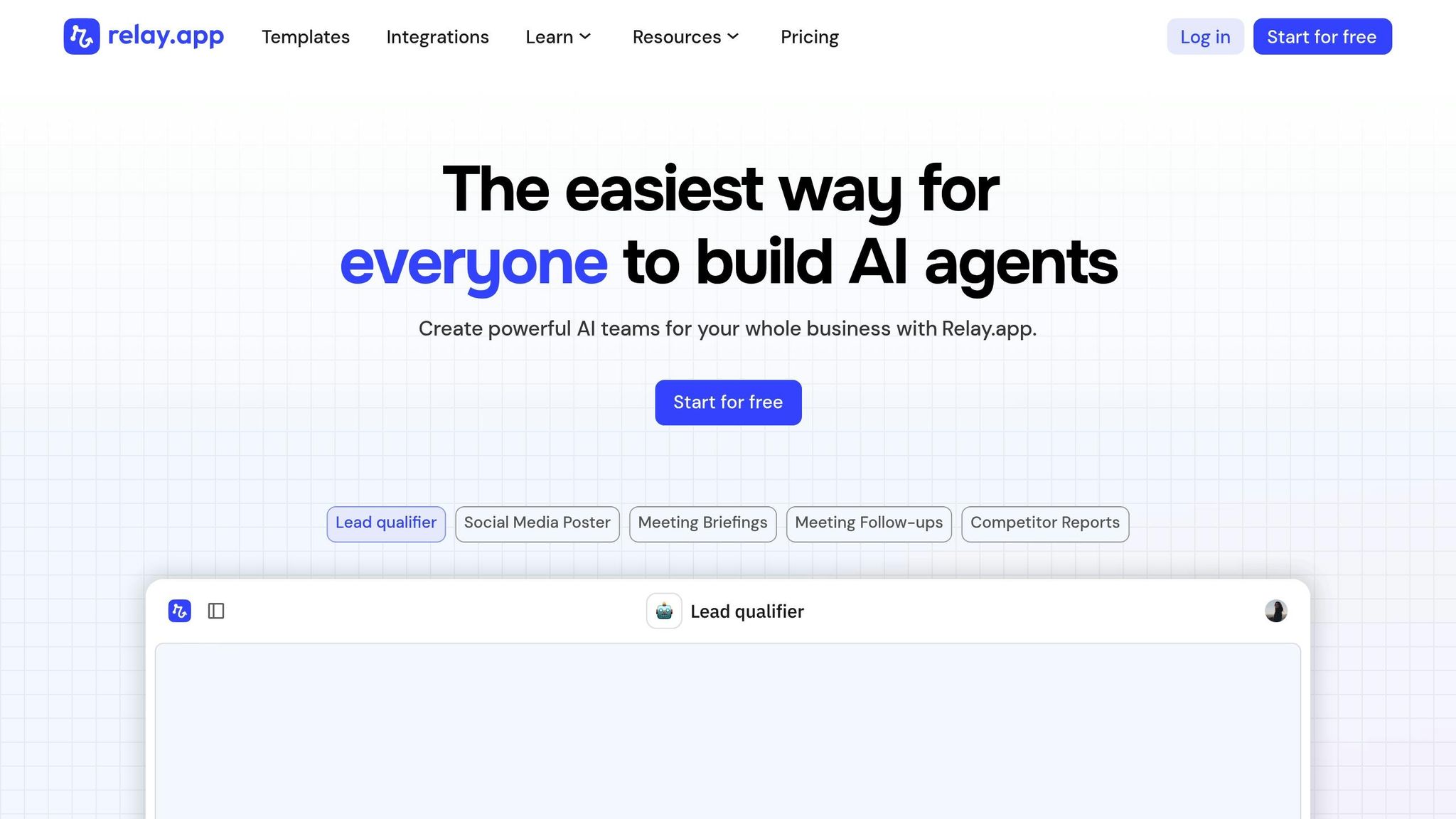
AI workflows can be chaotic without the right tools and strategies. Businesses often face tool sprawl, rising costs, and compliance headaches. This article breaks down five proven ways to improve AI efficiency and highlights platforms like Prompts.ai, Lindy.ai, and Relay.app that simplify workflows, cut costs, and ensure governance.

| Platform | Key Features | Best For |
|---|---|---|
| Prompts.ai | Unified LLM access, cost tracking, governance | Enterprises needing secure, scalable AI tools |
| Lindy.ai | Custom AI agents, multi-agent systems | Teams automating departmental tasks |
| Relay.app | Natural language task setup, human-in-the-loop | Businesses seeking simple cross-platform automation |
Efficient AI workflows aren’t just a luxury - they’re a necessity for scaling operations, cutting costs, and staying compliant. Platforms like Prompts.ai help businesses simplify processes and maximize AI's potential.
Tackling the challenges of AI workflows can feel overwhelming, but these five strategies can help simplify processes and improve efficiency.
No-code and low-code platforms make it easier for teams to build AI workflows without requiring deep technical expertise. For instance, marketing teams can set up workflows for content generation, sales teams can automate lead scoring, and customer service teams can deploy chatbots - all with minimal IT involvement.
These platforms provide drag-and-drop interfaces and pre-built AI connectors, allowing non-technical users to quickly prototype and launch automation. The result? Faster implementation and more flexibility across the organization.
Real-time monitoring is crucial for identifying issues before they disrupt operations. Unlike periodic checks, continuous monitoring tracks the behavior of AI systems in real-time, catching problems like performance drops or model drift as they happen.
Key metrics to monitor include response time and prediction accuracy. Without robust real-time analytics, many organizations experience delays and undetected errors, as studies have shown.
For AI systems built on microservices, distributed tracing is invaluable. By linking interactions across services with shared trace identifiers, teams can isolate the exact source of latency or errors within complex workflows.
Strong governance practices ensure AI systems meet regulatory requirements while maintaining transparency and accountability. Features like role-based access controls, audit trails, and explainability tools are essential components of a governance framework.
Explainability tools, in particular, help make AI decisions more transparent. By highlighting which features influenced a model’s predictions, these tools enable non-technical stakeholders to understand the reasoning behind AI outputs. This not only supports compliance with regulations like GDPR or HIPAA but also strengthens trust within the organization.
Additionally, security measures such as monitoring for unauthorized access, model tampering, and data pipeline changes are critical to maintaining compliance and protecting sensitive information.
Hyperautomation takes automation to the next level by combining AI, robotic process automation (RPA), and event triggers to streamline complex processes. This approach ensures that workflows adapt dynamically to changes in data or performance.
For example, when a customer submits an inquiry, hyperautomation can analyze sentiment, route the request to the right team, craft a personalized response, and update the CRM system - all without manual intervention.
To make hyperautomation successful, organizations need to integrate entire business processes. Identifying where tasks transition between departments and eliminating manual handoffs can significantly improve efficiency.
Managing AI costs can be challenging, especially as usage grows. FinOps practices bring financial transparency to AI operations by tracking expenses in real time and aligning spending with business goals.
Centralized dashboards, detailed resource tagging, and predictive cost models are key tools in FinOps. By tagging AI resources by department or project, teams can see exactly where money is being spent and make smarter decisions about resource allocation.
Setting spending alerts can help prevent budget overruns, ensuring that every dollar contributes to measurable outcomes. Predictive cost modeling further aids in planning by analyzing past usage and projecting future expenses, enabling more strategic investments in AI initiatives.
Prompts.ai streamlines AI workflows by bringing together access to models, cost management, governance, and collaborative prompt engineering in one secure platform. Below, we break down how these features enhance efficiency.
Prompts.ai provides seamless access to over 35 top-tier large language models, including GPT‑5, Claude, LLaMA, and Gemini, all within a single secure interface. This eliminates the hassle of juggling multiple API keys and vendor agreements, making model integration smoother and faster. The platform also allows side-by-side comparisons, enabling users to make data-driven decisions when selecting models.
June Chow, an architect who uses Prompts.ai, shared her experience:
"Now, by comparing different LLMs side‑by‑side on prompts.ai, she can bring complex projects to life while exploring innovative and dreamlike concepts."
By replacing 35 separate tools with one unified platform, Prompts.ai simplifies tech stacks and saves time during model selection and testing, increasing productivity by up to 10×.
Prompts.ai introduces a TOKN credit system that provides clear insights into spending across projects, teams, and models. Unlike traditional subscription plans with fluctuating costs, this system ties expenses directly to usage, supporting smarter financial operations. The platform’s Analytique dashboards offer real-time updates on spending and usage trends, while TOKN pooling allows teams to efficiently share credits across users and workspaces. Organizations have reported cutting costs by up to 98% by eliminating redundant subscriptions and optimizing model performance.
Prompts.ai ensures compliance with strict industry standards like SOC 2 Type 2, HIPAA, and GDPR, making it suitable for regulated industries. The platform began its SOC 2 Type 2 audit process on June 19, 2025, highlighting its commitment to robust security. Features such as role-based access controls and detailed audit trails provide full visibility into AI interactions, helping organizations maintain accountability. Additionally, the Trust Center offers real-time monitoring of security practices, ensuring governance without disrupting workflows.
Through its Prompt Engineer Certification program and global community, Prompts.ai promotes standardized practices for creating effective prompts. This collaborative ecosystem helps organizations adopt best practices faster and reduces onboarding challenges for new users. By engaging with this community, companies can cultivate internal experts to lead prompt engineering efforts and ensure consistent, high-quality AI outputs.
Prompts.ai’s flexible pricing model allows teams to manage budgets more effectively. The pay-as-you-go structure eliminates fixed monthly fees, letting users experiment with different models and workflows without financial risk. The transparency of the TOKN system also enables precise ROI tracking, linking AI investments directly to measurable business results. This approach supports strategic planning and sustainable AI adoption.
The right workflow platform can simplify and enhance AI-driven processes. Here’s a closer look at two standout platforms.

Lindy.ai simplifies the creation of AI agents by eliminating the need for complex coding. With just a few straightforward prompts, users can design custom AI agents that cater to various departmental needs. The platform’s model-agnostic approach allows users to select from leading AI models to power their agents, while hundreds of integrations ensure smooth connectivity with existing business tools.
Ken Aseme, CEO of VC CFO, aptly describes its value:
"It's like hiring a 24/7 ops teammate who never misses a deadline."
Lindy.ai employs multi-agent systems to automatically pull and integrate data from platforms like Google Drive and Notion, ensuring your knowledge base is always current. Security is a top priority, with compliance standards such as SOC 2, GDPR, HIPAA, and PIPEDA, along with AES-256 encryption. Additionally, the platform offers pre-built templates for tasks like sales lead qualification, email management, meeting coordination, and customer support, making it a versatile option for businesses.

Relay.app takes a fresh approach to workflow automation by using natural language instructions. Users simply describe the tasks they want their AI agent to handle, and the platform builds the workflows automatically. Its human-in-the-loop model ensures key steps can be manually reviewed, striking a balance between automation and oversight.
Lucas Grey, a Relay.app user, highlights its integration capabilities:
"Integrated GPT to parse waitlist email responses and save them into our Notion database."
Relay.app enables extensive cross-platform automation through integrations with major business applications like Airtable, Google Workspace, HubSpot, LinkedIn, Salesforce, Slack, and Zoom. It also supports a variety of advanced large language models, including Anthropic, Google Gemini, Groq, Mistral, OpenAI, Perplexity, Qwen, and xAI.
Choosing the right AI workflow platform means evaluating key aspects like model access, cost management, security, and ease of use. Prompts.ai stands out by combining all these features into one secure, streamlined interface.
| Platform | Key Strengths | LLM Support | Pricing Model | Security & Compliance | Best For |
|---|---|---|---|---|---|
| Prompts.ai | Centralized access to 35+ top LLMs, real-time cost tracking with FinOps tools, and enterprise-grade governance | GPT-5, Claude, LLaMA, Gemini, Grok-4, Flux Pro, Kling (plus 28+ others) | Pay-as-you-go TOKN credits; plans from $0 to $129/month | Full audit trails and advanced compliance measures | Enterprises needing unified AI tools with cost clarity |
Prompts.ai brings everything together to simplify AI workflows. Its unified platform offers access to over 35 leading LLMs, a flexible pay-as-you-go TOKN credit system that aligns costs with usage, and advanced governance features like audit trails to ensure compliance. Additionally, the platform supports collaborative prompt engineering, making it easier for teams to manage AI projects securely while meeting regulatory requirements. This all-in-one approach is designed to help organizations efficiently handle multiple AI initiatives without compromising on cost transparency or data safety.
Streamlining AI workflows has become an essential step for businesses aiming to scale efficiently while keeping costs in check and staying compliant. By the end of 2025, AI-enabled workflows are expected to surge from 3% to 25% of enterprise processes - a clear signal that effective orchestration is no longer optional but necessary.
This dramatic growth highlights the pressing need to shift from fragmented processes to integrated AI systems. A unified workflow platform transforms chaotic AI implementations into strategic assets, eliminating issues like siloed data, manual slowdowns, and reactive decision-making. Companies leveraging such platforms report improved productivity, seamless collaboration, and the agility to adapt quickly to changing market demands.
With real-time FinOps monitoring, businesses can avoid budget overruns, while comprehensive audit trails ensure compliance - critical for industries handling sensitive data.
Prompts.ai addresses these challenges head-on. By offering centralized access to over 35 leading LLMs, real-time cost tracking powered by TOKN credits, and enterprise-level governance, Prompts.ai simplifies AI management. Its community-driven prompt engineering and flexible pay-as-you-go pricing further enhance its appeal as a scalable solution.
Adopting unified workflows secures AI's role in driving future success. By integrating monitoring, cost management, and compliance into a single platform, organizations can unlock AI's full potential while sidestepping the risks of disjointed implementations. This underscores the importance of strategic, cohesive AI workflow management in today’s rapidly evolving landscape.
No-code and low-code platforms simplify the process of building and managing AI workflows, making it accessible even for teams without technical expertise. With user-friendly interfaces, pre-designed templates, and drag-and-drop functionality, these tools enable teams to create workflows quickly and efficiently - no advanced coding required.
By cutting down on setup complexities, these platforms save time and resources, allowing businesses to scale their AI solutions more rapidly while sidestepping many technical hurdles. They’re perfect for organizations aiming to equip diverse teams to harness AI capabilities without a heavy dependence on software developers.
Real-time monitoring and analytics bring a new level of efficiency to AI workflows, offering immediate insights into operations and performance. This capability enables organizations to keep a close eye on key metrics, spot emerging trends, and address potential challenges before they grow into larger problems. The result? Smoother, more streamlined processes.
With real-time data at their fingertips, teams can act quickly and make informed decisions that boost productivity and minimize downtime. These tools also play a crucial role in fine-tuning resource allocation and keeping AI systems aligned with business objectives, ultimately delivering stronger results across all areas.
Prompts.ai places a strong emphasis on compliance and governance, equipping users with powerful tools for monitoring, administration, and oversight. These capabilities ensure AI workflows stay aligned with both regulatory standards and internal organizational policies.
With clear controls and automated checks built into the platform, managing compliance becomes more straightforward. This approach not only simplifies oversight but also promotes transparency and accountability throughout AI-powered operations.


